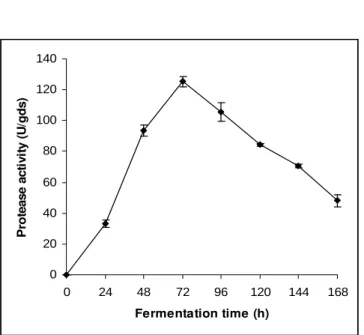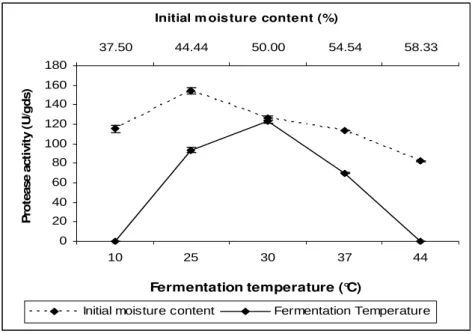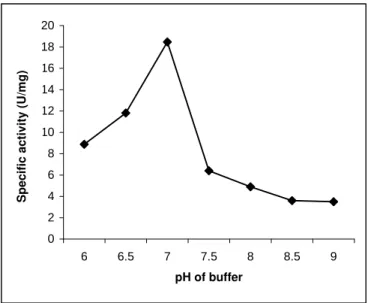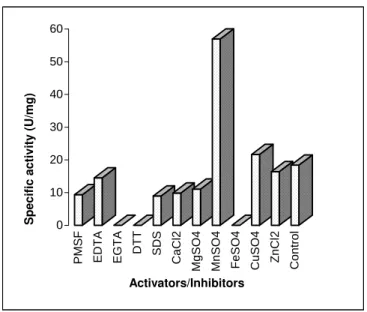Vol.49, n. 5 : pp. 843-851, September 2006
ISSN 1516-8913 Printed in Brazil BRAZILIAN ARCHIVES OF
BIOLOGY AND TECHNOLOGY
A N I N T E R N A T I O N A L J O U R N A L
Rice Bran as a Substrate for Proteolytic Enzyme Production
Alagarsamy Sumantha1, Paul Deepa1, Chandran Sandhya1, George Szakacs2, Carlos Ricardo Soccol3 and Ashok Pandey1*
1
Biotechnology Division; Regional Research Laboratory (CSIR); Trivandrum - India. 2Department of Agricultural Chemical Technology; Technical University of Budapest; Budapest - Hungary. 3Laboratório de Processos Biotecnológicos; Universidade Federal do Paraná; Curitiba - PR - Brasil
ABSTRACT
Rice bran was used as the substrate for screening nine strains of Rhizopus sp. for neutral protease production by solid-state fermentation. The best producer, Rhizopus microsporus NRRL 3671, was used for optimizing the process parameters for enzyme production. Fermentation carried out with 44.44 % initial moisture content at a temperature of 30 ˚C for 72 h was found to be the optimum for enzyme secretion by the fermenting organism. While most of the carbon supplements favored enzyme production, addition of casein resulted in a marginal increase in protease yield. Fermentation was then carried out under optimized conditions to obtain the crude extract of the enzyme, which was partially purified by precipitation and dialysis. A 3-fold increase in the enzyme purity was achieved in this manner. The enzyme was found to be a metalloprotease, being activated by Mn2+, with maximal activity at a temperature of 60 ˚C and pH 7.0.
Key words: Solid-state fermentation, Rice bran, Rhizopus, neutral protease, agro-industrial residues
*
INTRODUCTION
Rice bran is a by-product of the rice milling industry. In India, nearly one million tons of bran is produced every year. It has a high nutritive value and serves as a valuable feed for cattle, poultry, and pigs. Rice bran supplies almost the same amount of protein (10-15 %) as wheat and oats and its protein is of considerably better quality than maize (The Wealth of India, 2001). Rice bran has been used as a fermentation substrate for the production of enzymes such as
lipase by Candida sp. (Rao et al., 1993a; b), in
combination with cassava starch and rice hulls for
the production of glucoamylase by Aspergillus sp.
(Tani et al., 1986) and also with wheat bran for the
production of alkaline protease by Trichoderma
koningii (Manonmani and Joseph, 1993).
Proteases are proteolytic (protein-digesting)
enzymes that are mainly classified on the basis of their pH optimum as acidic, neutral, and alkaline
proteases. These biocatalysts find wide
applications in many industries such as textile, laundry, healthcare etc. Neutral proteases are mainly used in food processing such as baking, brewing, and also in the healthcare sector. One of the more recent applications of these proteases exploit their eco-friendly nature and hence their suitability to act as food-processing aids, wherein these enzymes can be used for the extraction of plant oils thus largely replacing hazardous organic solvents such as hexane which has been traditionally used for such processes.
bran (Fernandez-Lahore et al., 1998; Couri et al., 2000; Sandhya et al., 2005), steamed rice (Chou and Rwan, 1995), mango peel and banana peel (Couri et al., 2000), etc. Fermentation of rice bran by Rhizopus sp. has been reported, but only for the production of acid protease (Ikasari and Mitchell, 1996; 1998). There are no reports on the
production of neutral protease by Rhizopus sp.
Hence, the potential of rice bran to be used as a substrate for the production of neutral protease by Rhizopus sp. was investigated.
MATERIALS AND METHODS
Substrate
The substrate used in this study, rice bran, was obtained from a local market in Trivandrum.
Microorganism and maintenance of culture The Rhizopus strains, R. oligosporus NRRL 2710,
5905, R. microsporus NRRL 3671, R. oryzae
NRRL 1526, 1891, 6431, 395, 3562, 1472 were obtained from Northern Regional Research Laboratory, USA and grown on Potato Dextrose Agar (PDA) slants at 30 °C with fortnightly transfer to fresh medium.
Inoculum preparation
The inoculum was prepared by dispersing the spores from a week-old fungal slant culture in 0.1 % Tween-80 solution with a sterile inoculation loop.
Solid-state fermentation
Five grams of rice bran was taken in a 250 ml Erlenmeyer flask, moistened with salt solution [composition (% w/v): ammonium nitrate 0.5, potassium dihydrogen orthophosphate 0.2, sodium chloride 0.1, and magnesium sulphate 0.1] to achieve the desired moisture content, sterilized at 121.5 °C for 15 min, cooled, inoculated with 1 ml
of fungal spore suspension (106 spores/ml) and
incubated at 30 °C for 72 h, unless otherwise mentioned. All experiments were carried out in
two sets. The results shown are average values ±
SD.
Extraction of crude enzyme
A solution of Tween-80 (0.1 %) in distilled water was added to the fermented substrate and the substrate was homogenized on a rotary shaker at
180 rpm for 1 h. The solids were removed by
centrifuging the homogenate at 8000 x g at 4 °C
for 15 min and the resultant clear supernatant was used for analytical studies.
Analytical methods Assay for neutral protease
To 200 µl of crude enzyme extract, 500 µl of
casein (1 %) and 300 µl of 0.2 mol/l phosphate
buffer (pH 7.0) were added. The reaction mixture was incubated at 60 °C for 10 min and arrested by the addition of 1 ml of 10 % trichloroacetic acid (Keay and Wildi, 1970). The reaction mixture was
centrifuged at 8000 x g for 15 min and to the
supernatant, 5 ml of 0.4 mol/l Na2CO3 and 1 ml of
3-fold diluted Folin and Ciocalteau’s phenol reagent, were added. The resulting solution was incubated at room temperature for 30 min and the absorbance of the blue color developed was read at 660 nm using a tyrosine standard (Lowry et al., 1951). One unit of enzyme activity was defined as
the amount of enzyme that liberated 1 µg of
tyrosine from substrate (casein) per minute under assay conditions and reported in terms of protease activity per gram dry fermented substrate.
Estimation of total soluble protein
Protein concentration was determined by the method of Lowry et al. (1951) using bovine serum albumin as standard and was expressed as milligram protein per gram dry fermented substrate.
Screening of fungal neutral protease producers
The nine different Rhizopus strains were screened
for neutral protease production by performing SSF using rice bran as substrate.
Optimization of process parameters for neutral protease production
The protocol adopted for the optimization of process parameters was to evaluate the effect of an individual parameter at a time and to incorporate it at the standard level before optimizing the next parameter.
Optimization of incubation period
Optimization of incubation temperature
The inoculated substrates were incubated at different temperatures to determine the optimum fermentation temperature for neutral protease production (10, 25, 30, 37, and 44 °C).
Optimization of initial moisture content
Optimum initial moisture content for neutral protease production was determined by adjusting the initial moisture content of the fermentation substrate to varying levels (37.5, 44.4, 50, 54.5, and 58.3 %).
Effect of nutrient supplementation Effect of inorganic nitrogen supplements
Different sources of inorganic nitrogen
(NH4HCO3, NH4H2PO4, (NH4)2HPO4, NH4NO3,
NaNO3, KNO3, (NH4)2SO4, and NH4Cl) at 1 %
(w/w) were added to the fermentation medium to study its effect on enzyme production.
Effect of organic nitrogen supplements
Various organic nitrogen supplements (beef extract, casein, corn steep liquor, corn steep solids, malt extract, peptone, tryptone, and yeast extract) at a concentration of 1 % (w/w) were added to the fermentation media to study its effect on enzyme production.
Effect of carbon supplements
Influence of various carbon supplements on enzyme production was studied by adding different sugars (dextrose, maltose, sucrose, mannitol, sorbitol, xylose, lactose, and galactose) at 1 % (w/w) to the fermentation media.
Solid-state fermentation under optimized
conditions
Solid-state fermentation of rice bran by the
selected strain of Rhizopus was carried out under
the optimized conditions of time, temperature, initial moisture content, and nutrient supplements.
Partial purification of the enzyme
The crude enzyme sample was separated into three fractions, based on the percentage saturation of
ammonium sulphate, at 4 °C under constant
stirring. The precipitated proteins were pelletized
by centrifugation at 10000 x g at 4 °C for 15 min.
These proteins were dissolved in 0.2 mol/l
phosphate buffer (pH 7.0) and stored at 4 °C. The
precipitate was dialyzed against the same buffer at
4 °C for 24 h and the buffer was changed at regular intervals.
Characterization of the partially purified enzyme The partially purified fraction showing highest specific activity was characterized by varying the parameters that influence enzyme activity.
Substrate concentration
The effect of assay substrate concentration on the activity of neutral protease was studied by using different concentrations of casein (5, 10, 15, 20, 25, and 30 mg/ml).
pH optimum
The pHoptimum of the neutral protease enzyme
was determined by using buffer solutions of different pH (phosphate buffer 6.0, 6.5, 7.0, 7.5, 8.0, and tris-glycine buffer 8.5, 9.0) for enzyme assay. The buffers used were of the concentration 0.2 mol/l.
Temperature optimum
The influence of temperature on the activity of neutral protease was studied by incubating the assay reaction mixture at different temperatures (30, 35, 40, 45, 50, 55, 60, 65, 70, 75, 80, 85, 90, and 95 °C).
Effect of enzyme modulators
Different enzyme modulators (PMSF, EDTA, EGTA, DTT, CuSO4, SDS, CaCl2, MgSO4, MnSO4, FeSO4, ZnCl2) of concentration 0.1 mol/l, was added to the assay mixture to study their effect on enzyme activity.
RESULTS AND DISCUSSION
Table 1 - Protease production by different strains of Rhizopus sp. on rice bran substrate.
Microorganism Protease activity (U/gds)
R. oryzae 6431 32
R. oryzae 3562 62
R. oryzae 1891 31
R. oryzae 1472 53
R. oryzae 395 82
R. oryzae 1526 69
R. microsporus 3671 129
R. oligosporus 5905 43
R. oligosporus 2710 49
0 20 40 60 80 100 120 140
0 24 48 72 96 120 144 168
Fermentation time (h)
P
ro
te
a
s
e
a
c
ti
v
it
y
(
U
/g
d
s
)
Figure 1 - Optimization of fermentation time for neutral protease production by R. microsporus NRRL 3671
Screening of microorganisms
R. microsporus NRRL 3671 proved to be the best strain for neutral protease production on rice bran substrate giving 129 U/gds of enzyme activity
(Table 1). This Rhizopus strain was selected to
optimize the process parameters for enzyme production by the SSF of rice bran.
Fermentation time
Maximum enzyme production was observed after 72 h of fermentation (Fig. 1). A gradual decrease in enzyme units was observed with increasing incubation time clearly suggesting the enzyme’s role as a primary metabolite, being produced in the log phase of the growth of the fungus for utilization of nutrients (proteins) present in the solid substrate. The subsequent decrease in the enzyme units could probably be due to inactivation of the enzyme by other constituent proteases.
Initial moisture content
Initial moisture content is a crucial factor affecting the formation of products through solid-state fermentation. A moisture level of 44.4 % was found to be optimum for neutral protease production (Fig. 2). Moisture content of 35-40 %
facilitated neutral protease production by
Aspergillus oryzae NRRL 2160 on a combined substrate of rice hulls and rice bran (Battaglino et al., 1991).
Fermentation temperature
0 20 40 60 80 100 120 140 160 180
10 25 30 37 44
Initial m ois ture conte nt (%)
P
ro
te
a
s
e
a
c
ti
v
it
y
(
U
/g
d
s
)
37.50 44.44 50.00 54.54 58.33
Fermentation temperature (°C)
Initial moisture content Fermentation Temperature
Figure 2 - Effect of initial moisture content and fermentation temperature on enzyme production by R. microsporus NRRL 3671
Supplementation of nutrients
Supplementation of the fermentation medium with
NH4HCO3 was found to enhance enzyme
production (Table 2). Since no other inorganic
nitrogen compounds, e.g. NH4NO3 which has a
higher molar concentration of nitrogen than
NH4HCO3, enhanced protease production, the
enhancing effect of NH4HCO3 can not be
attributed to the nitrogen present in it, but could rather be due to the carbonate group. Carbonate as a constituent of the extraction buffer enhanced protease recovery from rice bran fermented by Aspergillus niger (Anupama and Ravindra, 2001). None of the organic nitrogen supplements enhanced protease production significantly, though casein showed a slightly promoting effect. Casein was found to be an inducer for protease synthesis
by Bacillus licheniformis MIR 29 (Ferrero et al., 1996).
Almost all of the carbon supplements, especially sucrose, enhanced enzyme production. Sucrose probably provides the much required carbon in the carbohydrate-deficient rice bran substrate, which contains only about 1.3 % of reducing sugars (The Wealth of India, 2001).
Partial purification
A better understanding of the function of enzyme could be determined by purification of enzyme (Sandhya et al., 2004). Partial purification of the enzyme by ammonium sulphate precipitation, followed by dialysis resulted in nearly a 3-fold increase in the specific activity of the enzyme (Table 3).
Table 2 - Influence of various nutrient supplements on enzyme production by R. microsporus NRRL 3671
Inorganic nitrogen supplement
Protease activity (U/gds)
Organic nitrogen supplement
Protease activity (U/gds)
Carbon supplement
Protease activity (U/gds)
NH4HCO3 195 Beef extract 188 Glucose 266
NH4H2PO4 65 Casein 214 Maltose 272
(NH4)2HPO4 117 Corn steep liquor 202 Sucrose 292
NH4NO3 71 Corn steep solids 193 Mannitol 235
NaNO3 150 Malt extract 197 Sorbitol 237
KNO3 130 Peptone 205 Xylose 197
(NH4)2SO4 79 Tryptone 207 Lactose 226
NH4Cl 27 Yeast Extract 200 Galactose 229
Table 3 - Increase in specific activity of neutral protease with partial purification
Enzyme fraction Specific activity (U/mg)
Crude enzyme 5.7
20-40% 6.3
40-60% 17
60-80% 16
Enzyme characterization Substrate concentration
The assay substrate, casein, when used at increasing concentrations resulted in the saturation
of the enzyme (Fig. 3). From Lineweaver-Burk
plot, the Km and Vmax of the reaction was found to
be 2.6 and 19.9 mg/min, respectively (data not shown).
0 2 4 6 8 10 12 14 16 18 20
0 5 10 15 20 25 30
Concentration of assay substrate (mg/ml)
Figure 3 - Reaction of the partially purified neutral protease of R. microsporus NRRL 3671 with its substrate, casein, and attainment of saturation at a casein concentration of 10 mg/ml
0 2 4 6 8 10 12 14 16 18 20
6 6.5 7 7.5 8 8.5 9
pH of buffer
Figure 4 - pH curve of the partially purified neutral protease of R. microsporus NRRL 3671
S
p
e
c
if
ic
a
c
ti
v
it
y
(
U
/m
g
pH
A gradual increase in specific activity to reach a peak at pH 7.0 was then followed by a sharp decline as shown in fig. 4 indicating the enzyme’s instability at any pH other than its optimum, viz.
7.0. A neutral metalloprotease from
Staphylococcus epidermidis also has pH optima in the range 5.0-7.0 (Teufel and Gotz, 1993).
Temperature
The partially purified enzyme was stable at a temperature range of 50-60 °C. The enzyme activity gradually increased with increasing temperature, followed by a steep decrease at temperatures above 60 °C (Fig. 5). A neutral metalloprotease exhibiting maximal activity at a temperature of 60 °C was purified from Aspergillus fumigatus (Markaryan et al., 1994).
0 2 4 6 8 10 12 14 16 18 20
30 35 40 45 50 55 60 65 70 75 80 85 90 95
Temperature (°C)
Figure 5 - Temperature curve of the partially purified neutral protease of R. microsporus NRRL 3671
0 10 20 30 40 50 60
P
M
S
F
E
D
TA
E
GTA DTT SD
S
C
a
C
l2
M
g
S
O4
M
n
S
O4
Fe
S
O4
C
u
S
O4
Zn
C
l2
C
o
n
tr
o
l
Activators/Inhibitors
Figure 6 - Effect of enzyme modulators on neutral protease activity after partial purification
S
p
e
c
if
ic
a
c
ti
v
it
y
(
U
/m
g
)
S
p
e
c
if
ic
a
c
ti
v
it
y
(
U
/m
g
Effect of activators/inhibitors
The effect of various activators and inhibitors at 0.1 mol/l concentration showed that the neutral
protease is a metalloenzyme requiring Mn2+ for its
activity (Fig. 6). The inhibition of enzyme activity by EGTA, EDTA also proved this. The enzyme was comparatively resistant to PMSF and SDS,
but highly sensitive to DTT. Cu2+ slightly
enhanced enzyme activity, but addition of other
metal ions such as Ca2+, Mg2+, Fe2+, and Zn2+ did
not improve enzyme activity. A neutral protease
from Bacillus subtilis that was activated by Mn2+
and a few other metal ions and susceptible to metal chelators such as EDTA was described by Yang et al. (2000), while the production of a neutral
metalloprotease by Bacillus thuringiensis var.
kurstaki was dependent upon the presence of Mn2+ in the fermentation medium (Li and Yousten, 1975).
ACKNOWLEDGEMENTS
The authors thank CSIR, India for providing financial support under the networked Task Force Project (CMM 0006). A. Sumantha gratefully acknowledges a Junior Research Fellowship from CSIR, India.
RESUMO
Farelo de arroz foi utilizado como substrato para seleção de nove linhagens de Rhizopus sp. com vistas a produção de protease neutra. A linhagem que apresentou maior produtividade da enzima foi Rhizopus microsporus NRRL 3671, sendo utilizada na otimização dos parâmetros do processos e produção da enzima. As condições otimizadas para produção da enzima foram 44% de umidade inicial, temperatura de 30ºC e 72h de fermentação.A suplementação do farelo de arroz com uma fonte de carbono favoreceu a produção da enzima, porém a adição de caseína resultou em um aumento marginal do rendimento em protease. Condições otimizadas foram utilizadas para obtenção do extrato cru da enzima que foi parcialmente purificado por precipitação e diálise. A enzima purificada teve sua atividade incrementada 3 vezes. A enzima foi classificada como metalo-protease, sendo ativada pelo Mn2+ , sendo que sua atividade máxima foi obtida a temperatura de 60ºC e a pH 7.0.
REFERENCES
Anupama and Ravindra, P. (2001), Studies on production of single cell protein by Aspergillus niger
in solid state fermentation of rice bran. Braz. Arch. Biol. Tech., 44, 79-88.
Battaglino, R. A.; Huergo, M.; Pilosof, A. M. R. and Bartholomai, G. B. (1991), Culture requirements for the production of protease by Aspergillus oryzae in solid state fermentation. Appl. Microbiol. Biotechnol.,
35, 292-296.
Chou, C. C. and Rwan, J. H. (1995), Mycelial propagation and enzyme production in koji prepared with Aspergillus oryzae on various rice extrudates and steamed rice. J. Ferment. Bioengg., 79, 509-512. Couri, S.; Terzi, S. C.; Pinto, G. A. S.; Freitas, S. P. and
Costa, A. C. A. (2000), Hydrolytic enzyme production in solid-state fermentation by Aspergillus niger 3T5B8. Process Biochem., 36, 255-261. Fernandez-Lahore, H. M.; Fraile, E. R. and Cascone, O.
(1998), Acid protease recovery from a solid-state fermentation system. J. Biotechnol., 62, 83-93. Ferrero, M. A.; Castro, G. R.; Abate, C. M.; Baigori, M.
D. and Sineriz, F. (1996), Thermostable alkaline proteases of Bacillus licheniformis MIR 29: isolation, production and characterization. Appl. Microbiol. Biotechnol., 45, 327-332.
Ikasari, L. and Mitchell, D. A. (1996), Leaching and characterization of Rhizopus oligosporus acid protease from solid-state fermentation. Enzyme Microb. Technol., 19, 171-175.
Ikasari, L. and Mitchell, D. A. (1998), Mimicking gas and temperature changes during enzyme production by Rhizopus oligosporus in solid-state fermentation.
Biotechnol. Lett., 20, 349-353.
Keay, L. and Wildi, B. S. (1970), Proteases of the genus Bacillus. I. Neutral proteases. Biotechnol. Bioengg.,
12, 179-212.
Li, E. and Yousten, A. A. (1975), Metalloprotease from
Bacillus thuringiensis, Appl. Microbiol., 30, 354-361. Lowry, O. H.; Rosebrough, N. J.; Farr, A. L. and
Randall, R. J. (1951), Protein measurement with Folin phenol reagent. J. Biol. Chem.,193, 265- 275. Manonmani, H. K. and Joseph, R. (1993), Purification
and properties of an extracellular proteinase by
Trichoderma koningii. Enzyme Microb. Technol., 15, 624-628.
Markaryan, A.; Morozova, I.; Yu, H. and Kolaitukudy, P. E. (1994), Purification and characterization of an elastinolytic metalloprotease from Aspergillus fumigatus and immunoelectron microscopic evidence of secretion of this enzyme by the fungus invading the murine lung. Infec. Immun., 62, 2149-2157. Rao, P. V.; Jayaraman, K. and Lakshmanan, C. M.
Rao, P. V.; Jayaraman, K. and Lakshmanan, C. M. (1993b), Production of lipase by Candida rugosa in solid-state fermentation. 2: Medium optimization and effect of aeration. Process Biochem., 28, 391-395. Sandhya, C.; Sumantha, A. and Pandey, A. (2004),
Proteases. In: Pandey, A.; Webb, C.; Soccol, C. R. and Larroche, C. (Eds.). Enzyme technology. New Delhi: Asiatech Publishers Inc. pp. 312-325.
Sandhya, C.; Sumantha, A.; Szakacs, G. and Pandey, A. (2005), Comparative evaluation of neutral protease production by Aspergillus oryzae in submerged and solid-state fermentation. Process Biochem., 40, 2689-2694.
Tani, Y.; Vongsuvanlert, V. and Kumnuanta, J. (1986), Raw cassava starch-digestive glucoamylase of
Aspergillus sp. N-2 isolated from cassava chips. J. Ferment. Technol., 64, 405-410.
Teufel, P. and Gotz, F. (1993), Characterization of an extracellular metalloprotease with elastase activity from Staphylococcus epidermidis. J. Bacteriol., 175, 4218-4224.
The Wealth of India: a dictionary of Indian raw materials and industrial products (2001), Raw materials. New Delhi: NISCOM. v. 7: N-Pe. pp. 110-191.
Yang, J. K.; Shih, I. L.; Tzeng, Y. M. and Wang, S. L. (2000), Production and purification of protease from a Bacillus subtilis that can deproteinize crustacean wastes. Enz. Microb. Technol., 26, 406-413.



